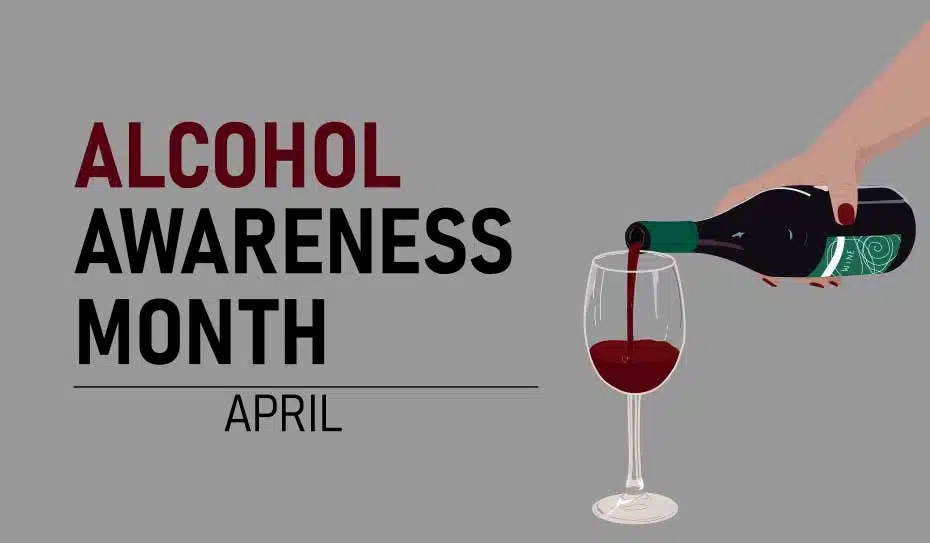How To Participate In Alcohol Awareness Month

About 84% of U.S. citizens have consumed alcohol at some point in their lives. While some people drink in moderation, others misuse alcohol. Alcohol misuse can lead to serious health problems, including alcohol use disorder (also called alcohol addiction).
Every April, you can help highlight the dangers of alcohol misuse by participating in National Alcohol Awareness Month.
What Is Alcohol Awareness Month?
Alcohol Awareness Month is an annual campaign that aims to educate the public on alcohol misuse. It was created in April 1987 by the National Council on Alcoholism and Drug Dependence (NCADD).
While it originally targeted college students, it now focuses on all age groups.
A Campaign To Spread Awareness & Reduce Stigma
Throughout Alcohol Awareness Month, organizations, communities, and individuals are encouraged to spread awareness about the risks of excessive alcohol consumption.
The campaign also seeks to reduce the stigma surrounding alcohol misuse. Stigma refers to judgment and discrimination based on a personal quality.
For example, people with alcohol use disorder are sometimes stigmatized as weak, lazy, or selfish. In reality, alcohol use disorder is a disease and not a moral failing.
When we work together to fight this stigma, we make it easier for people to admit they have alcohol problems and seek treatment.
How To Participate In Alcohol Awareness Month
To participate in Alcohol Awareness Month, all you have to do is share information about alcohol misuse.
Start Conversations
You could start conversations with family, friends, or coworkers. Consider mentioning any of your own experiences with excessive alcohol use. These honest discussions help reduce the stigma surrounding alcohol misuse and addiction.
Post On Social Media
You could also post on social media using the hashtag #AlcoholAwarenessMonth. Try posting on all of your accounts to reach as many people as possible.
Host A Community Event
If you’re feeling extra ambitious, consider hosting a community event.
The event should present information on alcohol misuse in an accessible, engaging way. For instance, you could hand out alcohol trivia cards along with snacks and non-alcoholic beverages. You can advertise the event on social media.
Share Facts About Binge Drinking & Heavy Drinking
According to the National Institute on Alcohol Abuse and Alcoholism (NIAAA), the most common types of alcohol misuse are binge drinking and heavy drinking.
Binge drinking occurs when a female has 4 or more drinks in about 2 hours or a male has 5 more drinks in about 2 hours. Heavy drinking occurs when a female has more than 3 drinks in one day or a male has more than 4 drinks in one day.
A standard drink is any beverage that contains about 14 grams of pure alcohol. In general, this amount of alcohol is found in 12 ounces of regular beer, 5 ounces of wine, and 1.5 ounces of liquor.
Detail The Effects Of Alcohol Misuse
Alcohol misuse can have both short-term and long-term effects.
Short-term effects of alcohol misuse may include:
- accidents and injuries, such as burns, falls, and motor vehicle crashes,
- violence, including intimate partner violence, sexual assault, and homicide
- risky sexual behaviors
- alcohol poisoning (also called alcohol overdose), which can be fatal
Long-term effects may include:
- weakened immune system liver disease
- high blood pressure
- heart disease
- stroke
- certain cancers, including breast cancer, throat cancer, and liver cancer
- anxiety, depression, and other mental health problems
- dementia and other memory problems
- damaged relationships
- job loss
Highlight The Signs Of Alcohol Use Disorder (AUD)
The most common signs of alcohol misuse and alcohol use disorder include:
- experiencing frequent cravings for alcohol
- falling behind at work or school due to alcohol use
- avoiding friends and family members so you can spend more time drinking
- continuing to drink even if it’s causing serious problems in your life
- feeling the need to lie about your drinking habits
- needing increasingly larger or more frequent drinks to feel the desired effects (also called tolerance)
- experiencing withdrawal symptoms (such as headache, nausea, or anxiety) when you don’t drink alcohol (also called physical dependence)
- feeling unable to stop drinking alcohol even if you want to
Help People Understand Treatment Options
If you or a loved one shows signs of alcohol use disorder, it’s important to seek help at an addiction treatment program. Most treatment plans include the following services:
- medical detox, in which doctors help you manage withdrawal symptoms as you get alcohol out of your system
- behavioral therapy, in which a mental health professional helps you cope with alcohol cravings and any mental health concerns that may have led you to misuse alcohol
- medication-assisted treatment, in which doctors prescribe medications to ease alcohol cravings and withdrawal symptoms
- support groups, such as Alcoholics Anonymous, in which you can discuss your experiences with other people recovering from alcohol use disorder
To learn more about treatment options for alcohol use disorder, please reach out to Spring Hill Recovery Center. Our board-certified healthcare providers offer a variety of evidence-based treatments to help you or your loved one build a fulfilling, alcohol-free life.
- Centers for Disease Control and Prevention — Drinking too much alcohol can harm your health https://www.cdc.gov/alcohol/fact-sheets/alcohol-use.htm
- National Institute on Alcohol Abuse and Alcoholism (NIAAA) — Alcohol Awareness Month: Learn About Alcohol Use Disorder and Ways to Get Help https://www.niaaa.nih.gov/about-niaaa/directors-page/niaaa-directors-blog/alcohol-awareness-month-learn-about-alcohol-use-disorder-and-ways-get-help
- National Institute on Alcohol Abuse and Alcoholism (NIAAA) — Alcohol Use in the United States https://www.niaaa.nih.gov/alcohols-effects-health/alcohol-topics/alcohol-facts-and-statistics/alcohol-use-united-states
- National Institute on Alcohol Abuse and Alcoholism (NIAAA) — Drinking Levels Defined https://www.niaaa.nih.gov/alcohol-health/overview-alcohol-consumption/moderate-binge-drinking
- National Institute on Alcohol Abuse and Alcoholism (NIAAA) — What Is A Standard Drink? https://www.niaaa.nih.gov/alcohols-effects-health/overview-alcohol-consumption/what-standard-drink

